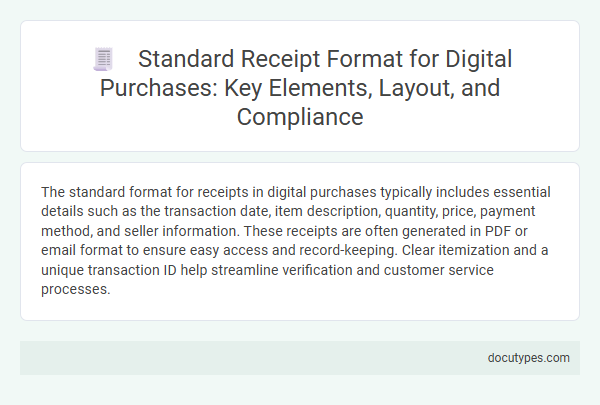The standard format for receipts in digital purchases typically includes essential details such as the transaction date, item description, quantity, price, payment method, and seller information. These receipts are often generated in PDF or email format to ensure easy access and record-keeping. Clear itemization and a unique transaction ID help streamline verification and customer service processes.
Introduction to Digital Receipt Standards
Digital receipts serve as essential records for purchases made online or through electronic payment systems. Standard formats ensure consistency, readability, and easy verification across platforms.
- Structured Data Format - Digital receipts commonly use structured data formats like JSON or XML to organize purchase information clearly.
- Key Receipt Elements - Standard digital receipts typically include merchant details, transaction date, itemized list, payment method, and total amount.
- Interoperability and Security - Receipt formats prioritize compatibility with accounting software and ensure secure transmission and storage of transaction data.
Importance of Standardized Digital Receipts
Digital purchase receipts follow a standard format to ensure clarity and consistency for consumers and businesses. Standardized digital receipts improve record-keeping, enhance customer trust, and streamline financial audits.
- Clear Itemization - Lists purchased products or services with prices and quantities for transparent transaction details.
- Purchase Information - Includes transaction date, time, payment method, and merchant details to verify authenticity.
- Digital Accessibility - Delivered via email or app, enabling easy storage, retrieval, and sharing of receipts.
Essential Elements of a Digital Purchase Receipt
The standard format for receipts in digital purchases includes specific essential elements to ensure clarity and validity. Key components consist of the seller's name, transaction date, itemized list of products or services purchased, total amount paid, and payment method used. Including a unique transaction or receipt ID and contact information for customer support further enhances the receipt's functionality and traceability.
Recommended Layout for Digital Receipts
| Section | Description |
|---|---|
| Header | Includes the merchant's name, logo, and contact information to establish brand identity and provide customer support details. |
| Purchase Details | Lists purchased items with descriptions, quantities, unit prices, and subtotal amounts for clear transaction information. |
| Transaction Information | Displays the date and time of purchase, payment method, transaction ID, and authorization details to validate the sale. |
| Total Amount | Shows the subtotal, taxes, discounts, and final amount paid, ensuring transparency of cost breakdown. |
| Customer Information | Includes the buyer's name and email address to personalize the receipt and facilitate record keeping. |
| Return and Refund Policy | Details terms of returns, exchanges, and refunds to inform consumer rights and procedures. |
| Footer | Provides additional notes, support contact, links to digital resources, and legal disclaimers to complete the receipt. |
Key Information to Include in Digital Receipts
Digital purchase receipts follow a standard format to ensure clear communication of transaction details. Key information helps maintain transparency and provides a reliable record for both the buyer and seller.
- Transaction Date and Time - Shows when the purchase was made to verify the timing of the transaction.
- Itemized List of Products or Services - Details each product or service purchased, including quantity and price.
- Payment Method and Total Amount - Specifies how the payment was made and the total cost including taxes or fees.
A comprehensive digital receipt includes these elements to support effective record-keeping and customer service.
Compliance Requirements for Digital Purchase Receipts
The standard format for receipts in digital purchases includes essential details such as the transaction date, item description, price, payment method, and seller information. Compliance requirements ensure these receipts meet legal standards for transparency and record-keeping across various jurisdictions.
Your digital purchase receipt must also include tax information and a unique transaction identifier to comply with financial regulations. Proper formatting improves data accuracy, supports tax reporting, and protects consumer rights in the digital marketplace.
Security and Privacy Considerations
The standard format for receipts in digital purchases typically includes the transaction date, itemized list of products or services, total amount paid, and payment method. Security measures ensure encryption of sensitive data such as credit card information and personal details to prevent unauthorized access. Your privacy is protected by compliance with data protection regulations, limiting data retention to necessary periods and allowing secure receipt delivery via encrypted channels.
Best Practices for Digital Receipt Design
The standard format for receipts in digital purchases includes clear details such as transaction date, item description, price, payment method, and seller information. This format ensures transparency and helps customers keep accurate records.
Best practices for digital receipt design emphasize simplicity, legibility, and mobile-friendliness. Include essential information prominently, use a clean layout with readable fonts, and ensure the receipt is easily accessible via email or app. Your digital receipt should also offer options to download or print for convenience and record-keeping.
Common Mistakes in Digital Receipt Formatting
The standard format for receipts in digital purchases typically includes the seller's information, transaction date, itemized list of products or services, prices, taxes, and total amount paid. Clear presentation of payment methods and confirmation numbers is essential for both record-keeping and customer reference.
Common mistakes in digital receipt formatting involve missing critical details such as the transaction date or item description, which can confuse customers during returns or audits. Another frequent error is the use of unclear fonts or poor layout, making it difficult for you to quickly verify purchase information.
What Is the Standard Format for Receipts in Digital Purchases? Infographic

